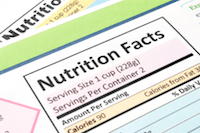 The supermarket can be a daunting place to visit. If you are trying to maintain a healthy lifestyle, the choices and messages you get can become overwhelming. Nutrition experts and health professionals will often tell you to read food labels to help you make healthy choices, but the labels themselves can send a number of messages.
The supermarket can be a daunting place to visit. If you are trying to maintain a healthy lifestyle, the choices and messages you get can become overwhelming. Nutrition experts and health professionals will often tell you to read food labels to help you make healthy choices, but the labels themselves can send a number of messages.
Food packaging is specifically designed to encourage you to buy things. Make no mistake. That is the first and foremost goal of all brands. The colours, images and words used have been painstakingly researched to speak as directly to you as possible. Food companies want you to choose their product over everyone else’s, and they will make all kinds of suggestions to assist you in your decision.
There is certainly no crime in this, it’s business. However, before you come home feeling delighted about choosing such healthy food, here are some of the key words you may see, which should possibly raise red flags.
Low fat/fat free/low salt/ all natural or sugar free
Food needs to taste good. Our taste buds recognise sweet, salty, bitter and sour most easily. Food that traditionally tastes great (with the exception of fruit and vegetables and other food from nature), usually contains fat, salt, sugar or other additives to make it so. If one part is removed (e.g. salt, sugar or fat), there is a high likelihood that something has been replaced to maintain flavour. Low fat foods are often extremely high in sugar, or food that has a low level of sugar may contain artificial sweetener.
A food can still legitimately be called all natural, even if it contains very high levels of health-compromising natural ingredients.
As a rule of thumb, if the ingredient list reads more like a science text book than a recipe book, approach it with caution. Food labels are listed with the highest quantities first.
Gluten free/nut free
If you are a coeliac or have an allergic reaction to nuts for example, read labels carefully. It is important to ensure that no products containing gluten or nuts are produced in the same kitchen. On the subject of gluten, if you do not have a professionally diagnosed intolerance or allergy, you may not be doing your health any good by avoiding gluten.
Free range/made with real fruit/organic
These statements are all open to interpretation. Free range eggs are more expensive than their ‘battery’ variety due to the extra space and expense required to produce them. However, there have been found to be enormous variations in what can be considered free range. Read the label closely and check for any additional information.
'Made with real fruit' does not mean that the product only contains real fruit. Look for the actual percentage of real fruit. It may be as little as 2-5%.
'Organic' is also widely open to interpretation. Studies have also found that organic does not necessarily mean a higher nutritional value and it is sometimes hard to prove that all parts of the production process are organic.
Serving sizes
If you are watching your weight, it is important to check the serving sizes and what they actually look like. Breakfast cereal is a prime example. Often the serving size is 30g, for the purposes of calorie count, carbohydrate measure etc. 30g can be as little as 1/3 of a standard measuring cup. Many of us pour a far more generous serving and unwittingly imbibe extra calories.
As adults, you are welcome to buy whatever you like, but don’t blindly believe the claims on all of our food packaging. Ask questions, and if in doubt, contact the manufacturers. There is always a contact number or email address on the packet. Being curious can be extremely good for you!










Join the Discussion
Type out your comment here:
You must be logged in to post a comment.